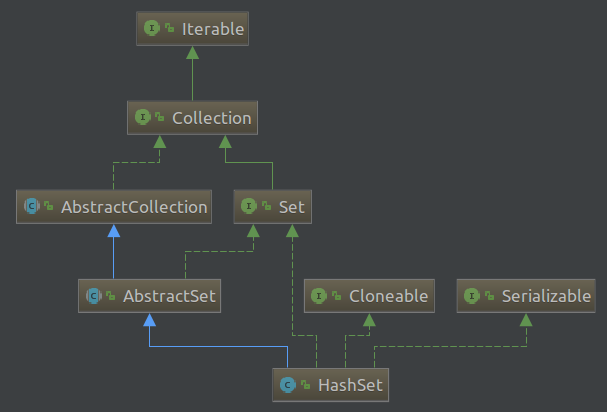HashSet代码分析
HashSet (jdk 1.7)的继承关系如下:

HashSet是使用HashMap实现的一个没有重复元素的集合。HashSet用法如下:
HashSet<String> hashSet = new HashSet<String>();
hashSet.add("java001");
hashSet.add("java01");
hashSet.add("java011");
hashSet.add("java002");
hashSet.add("java004");
从HashSet的add()方法可以看出,只有一个参数,并没有【键-值对】。
其实是HashSet只使用了HashMap的key,value统一是一个固定的Object,因此保证没有重复元素的方法,也是使用的HashMap的key来保证的。
既然HashSet是使用HashMap来实现的,那么HashSet必然会有一个HashMap的对象,即:
private transient HashMap<E,Object> map;
// Dummy value to associate with an Object in the backing Map
private static final Object PRESENT = new Object();
/**
* Constructs a new, empty set; the backing <tt>HashMap</tt> instance has
* default initial capacity (16) and load factor (0.75).
*/
public HashSet() {
map = new HashMap<>();
}
其中,PRESENT = new Object()是用来作为HashMap的value使用的。可以通过其add()方法看到
/**
* Adds the specified element to this set if it is not already present.
* More formally, adds the specified element <tt>e</tt> to this set if
* this set contains no element <tt>e2</tt> such that
* <tt>(e==null ? e2==null : e.equals(e2))</tt>.
* If this set already contains the element, the call leaves the set
* unchanged and returns <tt>false</tt>.
*
* @param e element to be added to this set
* @return <tt>true</tt> if this set did not already contain the specified
* element
*/
public boolean add(E e) {
return map.put(e, PRESENT)==null;
}
在add()方法,添加的元素作为key,PRESENT作为value。
remove()方法也是调用的HashMap的remove()方法
/**
* Removes the specified element from this set if it is present.
* More formally, removes an element <tt>e</tt> such that
* <tt>(o==null ? e==null : o.equals(e))</tt>,
* if this set contains such an element. Returns <tt>true</tt> if
* this set contained the element (or equivalently, if this set
* changed as a result of the call). (This set will not contain the
* element once the call returns.)
*
* @param o object to be removed from this set, if present
* @return <tt>true</tt> if the set contained the specified element
*/
public boolean remove(Object o) {
return map.remove(o)==PRESENT;
}
同样,size() / isEmpty() / contains() / clear() 都是调用的HashMap相应的方法。
/**
* Returns the number of elements in this set (its cardinality).
*
* @return the number of elements in this set (its cardinality)
*/
public int size() {
return map.size();
}
/**
* Returns <tt>true</tt> if this set contains no elements.
*
* @return <tt>true</tt> if this set contains no elements
*/
public boolean isEmpty() {
return map.isEmpty();
}
/**
* Returns <tt>true</tt> if this set contains the specified element.
* More formally, returns <tt>true</tt> if and only if this set
* contains an element <tt>e</tt> such that
* <tt>(o==null ? e==null : o.equals(e))</tt>.
*
* @param o element whose presence in this set is to be tested
* @return <tt>true</tt> if this set contains the specified element
*/
public boolean contains(Object o) {
return map.containsKey(o);
}
/**
* Removes all of the elements from this set.
* The set will be empty after this call returns.
*/
public void clear() {
map.clear();
}
另外,HashSet中有个更明显的方法来说明【HashSet只使用了HashMap的key】,即iterator()方法
/**
* Returns an iterator over the elements in this set. The elements
* are returned in no particular order.
*
* @return an Iterator over the elements in this set
* @see ConcurrentModificationException
*/
public Iterator<E> iterator() {
return map.keySet().iterator();
}






 浙公网安备 33010602011771号
浙公网安备 33010602011771号